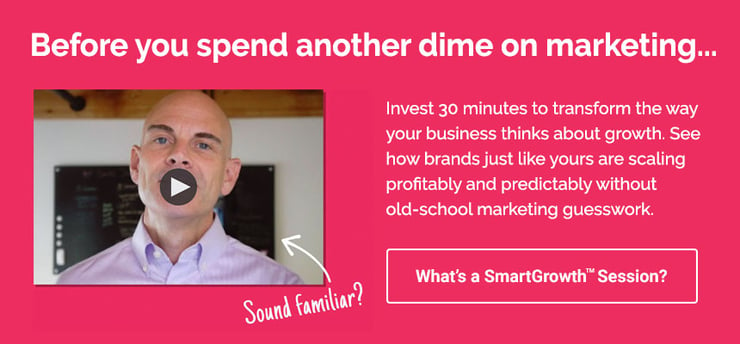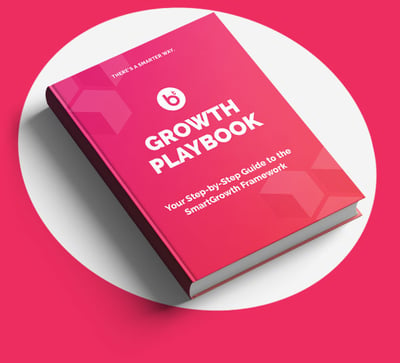You’ve created an MVP (minimum viable product), are building brand awareness via your website and social channels, and are working toward product-market fit. You realize marketing is an essential next step in getting your B2B SaaS company not just down the runway but to a successful market launch and on a path to sustainable growth. And as your solution gains traction, you might think it’s time to jump headfirst into digital marketing or a website redesign, but in fact, that’s exactly what you don’t want to do.
Why not? Because first, you need to build a foundation.
Enter the B2B SaaS marketing playbook.
What is a B2B SaaS Marketing Playbook?
It’s everything you need to know to establish the foundation for your marketing efforts so that your messaging, strategy, and user experience are in alignment with your current stage of growth. Think of it as a road map to approaching marketing strategically and methodically, so you are marketing with purpose, not just throwing darts at a wall to see what sticks. This is particularly important for SaaS companies, who do not have a year to waste on ineffective marketing. The B2B SaaS marketing playbook is a crucial element in your go-to-market strategy and can align your marketing efforts with your growth stages to keep your company growing, steadily and predictably.
Key Components of the SaaS Marketing Playbook
Chapter 1: Build your foundation
Before you invest in redesigning your website or diving into digital marketing, it’s important to think through who your target audience is, what makes your solution unique, and how you are different from your competitors. Creating a value proposition for your product is one of the best places to start. A value proposition is a concise statement that summarizes why a customer would buy your software. It encapsulates what sets you apart from your competition and how the product benefits the customer.
Next, you’ll want to build on this statement by creating a brand positioning statement. This is a broader statement that includes a description of your product and target audience and how your product or service solves a problem or fills a customer's need. Taking the time to craft these statements helps clearly define both the audience and the appropriate messaging for all the key stakeholders in your company so that individual departments are working from the same foundation and directing their messaging to the same ideal audience.
Chapter 2: Align marketing efforts with growth stages
Now that you have a solid foundation of who your ideal customers are, what sets your company apart, and how your software changes their lives for the better, it’s time to dive into marketing. Note that the channels, methods, and platforms will shift as your B2B SaaS company grows, so it’s important to stay nimble and be open to pivoting as you move through your go-to-market strategy.
The first place any start-up begins with marketing is in building awareness. This is no different for B2B SaaS. Thankfully, you’ve narrowed down your audience from Everyone on the Planet to something more approachable - like US financial institutions, or small business owners in North America. Having a grasp on who your target audience is, where they spend time, and how they engage online has already streamlined your marketing efforts and spared you time and money. So you can begin building awareness with this specific audience, on the channels where they spend the most time, and with the messaging that is most likely to resonate with them.
Some of our favorite marketing strategies for this stage? SEO, social media, paid search and paid social, content marketing (i.e., blogs, webinars, podcasts, and case studies). The best approaches will be dictated by your target audience and your brand personality.
Next, as you gain traffic and prospective customers, it’s important to convert visitors into leads or MQLs and nudge them into the sales funnel via lead magnets and other lead-generation tactics. SEO and content marketing remain important in this phase, as those inbound strategies help bring organic traffic to your website. Email marketing, gated content, and webinars can also be useful here.
Finally, as your B2B SaaS hits the marketplace and prepares to scale, your marketing strategy should broaden its focus to include tracking and analyzing growth marketing metrics. Here you’ll want to monitor the data along your SaaS sales funnel, keeping an eye on churn rates and looking out for any place along the buyer journey where customers might be getting stuck, or worse, falling off.
Chapter 3: Maintain
The last stage is to keep your well-oiled marketing machine running flawlessly. Sounds easier than it is, but hopefully by this stage, you have a very clear picture of who your customers are, what messaging is most effective, and are keeping an eye on the metrics most relevant to each stage of the customer journey so you can address potential problems before they become overwhelming.
In this phase, you’ll want to nurture your existing customers with product improvements, referral incentives, and amazing customer service. Additionally, keep up the strategies that are working best from building awareness to generating leads to closing deals. If your audience loves video, invest more heavily in video. If free trials have been successful - how can you make them even more appealing? Does Twitter feel like a waste of time? Maybe try TikTok instead. The point is to monitor how it’s working from a broad perspective. Don’t be afraid to tweak or change things that are no longer bringing you results. Finally, don’t neglect to continue creating consistent quality content. This provides value to your existing customers, bolsters your domain authority, and will continue to generate traffic to your site.
How can the B2B SaaS Marketing Playbook help you?
For busy startup founders who are already juggling multiple roles, it's easy to get caught up in the momentum of building a new company and simply dive into marketing without first surveying the waters by developing a plan. Following the steps in this B2B SaaS marketing playbook will ensure that you aren’t squandering resources with messages that are ineffective for your brand and fail to reach your ideal customer. This approach is also tailored to the growth stages of a SaaS company – aligning your marketing tactics with your business goals to keep you moving steadily and strategically forward.
Creating a successful marketing strategy for your B2B SaaS takes time and energy, but this focused approach is both efficient and effective at a time when both time and money are in limited supply. In fact, it’s the same approach we use with SaaS clients at Brand Theory. Curious about outsourcing your marketing to an experienced B2B SaaS marketing partner. Book a free, no-pressure consultation today.




.png)
.png)
.png)
